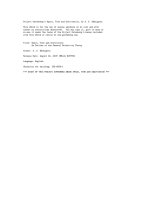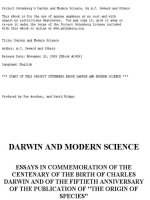Project Gutenberg''''s Form and Function, by E. S. (Edward Stuart) Russell pptx
Bạn đang xem bản rút gọn của tài liệu. Xem và tải ngay bản đầy đủ của tài liệu tại đây (3.35 MB, 1,264 trang )
Project Gutenberg's Form and Function, by
E. S. (Edward Stuart) Russell
This eBook is for the use of anyone
anywhere at no cost and with
almost no restrictions whatsoever. You may
copy it, give it away or
re-use it under the terms of the Project
Gutenberg License included
with this eBook or online at
www.gutenberg.org
Title: Form and Function
A Contribution to the History of Animal
Morphology
Author: E. S. (Edward Stuart) Russell
Release Date: January 23, 2007 [EBook
#20426]
Language: English
*** START OF THIS PROJECT GUTENBERG EBOOK
FORM AND FUNCTION ***
Produced by Suzanne Lybarger, Turgut
Dincer and the Online
Distributed Proofreading Team at
(This
file was produced from images generously
made available
by The Internet Archive/Canadian
Libraries)
FORM AND
FUNCTION
A CONTRIBUTION TO THE
HISTORY OF ANIMAL
MORPHOLOGY
By E. S. RUSSELL,
M.A., B.Sc., F.Z.S.
ILLUSTRATED
LONDON
JOHN MURRAY, ALBEMARLE
STREET, W.
1916
All rights reserved
Transcriber's Note:
Obvious printer errors
have been corrected, all
other inconsistencies in
spelling and punctuation
are as in the original.
PREFACE
This book is not intended to be a full or
detailed history of animal morphology: a
complete account is given neither of
morphological discoveries nor of
morphological theories. My aim has been
rather to call attention to the existence of
diverse typical attitudes to the problems
of form, and to trace the interplay of the
theories that have arisen out of them.
The main currents of morphological
thought are to my mind three—the
functional or synthetic, the formal or
transcendental, and the materialistic or
disintegrative.
The first is associated with the great
names of Aristotle, Cuvier, and von Baer,
and leads easily to the more open vitalism
of Lamarck and Samuel Butler. The
typical representative of the second
attitude is E. Geoffroy St. Hilaire, and this
habit of thought has greatly influenced the
development of evolutionary morphology.
The main battle-ground of these two
opposing tendencies is the problem of the
relation of function to form. Is function the
mechanical result of form, or is form
merely the manifestation of function or
activity? What is the essence of life—
organisation or activity?
The materialistic attitude is not
distinctively biological, but is common to
practically all fields of thought. It dates
back to the Greek atomists, and the
triumph of mechanical science in the 19th
century has induced many to accept
materialism as the only possible scientific
method. In biology it is more akin to the
formal than to the functional attitude.
In the course of this book I have not
hidden my own sympathy with the
functional attitude. It appears to me
probable that more insight will be gained
into the real nature of life and organisation
by concentrating on the active response of
the animal, as manifested both in
behaviour and in morphogenesis,
particularly in the post-embryonic stages,
than by giving attention exclusively to the
historical aspect of structure, as is the
custom of "pure morphology." I believe
we shall only make progress in this
direction if we frankly adopt the simple
everyday conception of living things—
which many of us have had drilled out of
us—that they are active, purposeful
agents, not mere complicated aggregations
of protein and other substances. Such an
attitude is probably quite as sound
philosophically as the opposing one, but I
have not in this place attempted any
justification of it. I have touched very
lightly upon the controversy between
vitalism and materialism which has been
revived with the early years of the present
century. It hardly lends itself as yet to
historical treatment, and I could hardly
hope to maintain with regard to it that
objective attitude which should
characterise the historian.
The main result I hope to have achieved
with this book is the demonstration,
tentative and incomplete as it is, of the
essential continuity of animal morphology
from the days of Aristotle down to our
own time. It is unfortunately true that
modern biology, perhaps in consequence
of the great advances it has made in
certain directions, has to a considerable
extent lost its historical consciousness,
and if this book helps in any degree to
counteract this tendency so far as animal
morphology is concerned, it will have
served its purpose.
I owe a debt of gratitude to my friends Dr
James F. Gemmill and Prof. J. Arthur
Thomson for much kindly encouragement
and helpful criticism. The credit for the
illustrations is due to my wife, Mrs
Jehanne A. Russell. One is from Nature;
the others are drawn from the original
figures.
E. S. R.
CHELSEA, 1916.
CONTENTS
CHAP.
Page
I. The Beginnings of
Comparative Anatomy 1
II. Comparative Anatomy before
Cuvier 17
III. Cuvier 31
IV. Goethe 45
V. Etienne Geoffroy St Hilaire 52
VI. The Followers of Etienne
Geoffroy St Hilaire 79
VII. The German
Transcendentalists 89
VIII. Transcendental Anatomy in
England—Richard Oven 102
IX. Karl Ernst von Baer 113
X. The Embryological Criterion 133
XI. The Cell-Theory 169
XII. The Close of the Pre-
evolutionary Period 190
XIII. The Relation of Lamarck and
Darwin to Morphology 213
XIV. Ernst Haeckel and Carl
Gegenbaur 246
XV. Early Theories on the Origin
of Vertebrates 268
XVI. The Germ-layers and
Evolution 288
XVII. The Organism as an
Historical Being 302
XVIII. The Beginnings of Causal
Morphology 314
XIX. Samuel Butler and the
Memory Theories of
Heredity 335
XX. The Classical Tradition in
Modern Morphology 345
Index 365
ILLUSTRATIONS
FIG.
Page
1. Hyoid Arch of the Conger.
(Original.) 58
2. "Vertebra" of a Pleuronectid.
(Geoffroy.) 61
3. Abdominal Segment of the
Lobster. (Geoffroy.) 63
4. Ideal Typical Vertebra. (Owen.) 102
5. Natural Typical Vertebra.
(Owen.) 103
6. The Archetype of the Vertebrate
Skeleton. (Owen.)
105
7. Ideal Transverse Section of a
Vertebrate Embryo. (Von
Baer.)
119
8. Gill-slits of the Pig Embryo.
(Rathke.) 134
9. Meckel's Cartilage and Ear-
ossicles in Embryo of Pig.
(Reichert.) 145
10. Cranial Vertebræ and Visceral
Arches in Embryo of Pig.
(Reichert.) 148
11. Embryonic Cranium of the
Adder. (Rathke.) 152
12. Transverse Section of Chick
Embryo. (Remak.) 211
13. Development of the Ascidian
Larva (Kowalevsky.) 272
14. Transverse Section of the Worm
NAIS. (Semper.)
280
15. The Five Primary Stages of
Ontogeny. (Haeckel.) 292
FORM AND
FUNCTION
CHAPTER I
THE BEGINNINGS OF COMPARATIVE
ANATOMY
The first name of which the history of
anatomy keeps record is that of Alcmaeon,
a contemporary of Pythagoras (6th century
B.C.). His interests appear to have been
rather physiological than anatomical. He
traced the chief nerves of sense to the
brain, which he considered to be the seat
of the soul, and he made some good
guesses at the mechanism of the organs of
special sense. He showed that, contrary to
the received opinion, the seminal fluid did
not originate in the spinal cord. Two
comparisons are recorded of his, one that
puberty is the equivalent of the flowering
time in plants, the other that milk is the
equivalent of white of egg.
[1]
Both show
his bias towards looking at the functional
side of living things. The latter
comparison reappears in Aristotle.
A century later Diogenes of Apollonia
gave a description of the venous system.
He too placed the seat of sensation in the
brain. He assumed a vital air in all living
things, being in this influenced by
Anaximenes whose primitive matter was
infinite air. In following out this thought he
tried to prove that both fishes and oysters
have the power of breathing.
[2]
A more strictly morphological note is
struck by a curious saying of Empedocles
(4th century B.C.), that "hair and foliage
and the thick plumage of birds are one."
[3]
In the collected writings of Hippocrates
and his school, the Corpus
Hippocraticum, of which no part is later
than the end of the 5th century, there are
recorded many anatomical facts. The
author of the treatise "On the Muscles"
knew, for instance, that the spinal marrow
is different from ordinary marrow and has
membranes continuous with those of the
brain. Embryos of seven days (!) have all
the parts of the body plainly visible. Work
on comparative embryology is contained
in the treatise "On the Development of the
Child."
[4]
The author of the treatise "On the Joints,"
which Littré calls "the great surgical
monument of antiquity," is to be credited
with the first systematic attempt at
comparative anatomy, for he compared the
human skeleton with that of other
Vertebrates.
Aristotle (384-322 B.C.)
[5]
may fairly be
said to be the founder of comparative
anatomy, not because he was specially
interested in problems of "pure
morphology," but because he described
the structure of many animals and
classified them in a scientific way. We
shall discuss here the morphological ideas
which occur in his writings upon animals
—in the HISTORIA ANIMALIUM , the De
PARTIBUS ANIMALIUM , and the De
Generatione Animalium.
T h e HISTORIA ANIMALIUM is a most
comprehensive work, in some ways the
finest text-book of Zoology ever written.
Certainly few modern text-books take such
a broad and sane view of living creatures.
Aristotle never forgets that form and
structure are but one of the many
properties of living things; he takes quite
as much interest in their behaviour, their
ecology, distribution, comparative
physiology. He takes a special interest in
the comparative physiology of
reproduction. The HISTORIA ANIMALIUM
contains a description of the form and
structure of man and of as many animals as
Aristotle was acquainted with—and he
was acquainted with an astonishingly
large number. The later DE PARTIBUS
Animalium is a treatise on the causes of
the form and structure of animals. Owing
to the importance which Aristotle
ascribed to the final cause this work
became really a treatise on the functions
of the parts, a discussion of the problems
of the relation of form to function, and the
adaptedness of structure.
Aristotle was quite well aware that each
of the big groups of animals was built
upon one plan of structure, which showed
endless variations "in excess and defect"
in the different members of the group. But
he did not realise that this fact of
community of plan constituted a problem
in itself. His interest was turned towards
the functional side of living things, form
was for him a secondary result of function.
Yet he was not unaware of facts of form
for which he could not quite find a place
in his theory of organic form, facts of form
which were not, at first sight at least, facts
of function. Thus he was aware of certain
facts of "correlation," which could not be
explained off-hand as due to correlation of
the functions of the parts. He knew, for
instance, that all animals without front
teeth in the upper jaw have cotyledons,
while most that have front teeth on both
jaws and no horns have no cotyledons (De
Gen., ii. 7).
Speaking generally, however, we find in
Aristotle no purely morphological
concepts. What then does morphology
owe to Aristotle? It owes to him, first, a
great mass of facts about the structure of
animals; second, the first scientific
classification of animals;
[6]
third, a clear
enunciation of the fact of community of
plan within each of the big groups; fourth,
an attempt to explain certain instances of
the correlation of parts; fifth, a pregnant
distinction between homogeneous and
heterogeneous parts; sixth, a
generalisation on the succession of forms
in development; and seventh, the first
enunciation of the idea of the ÉCHELLE DES
êtres.









